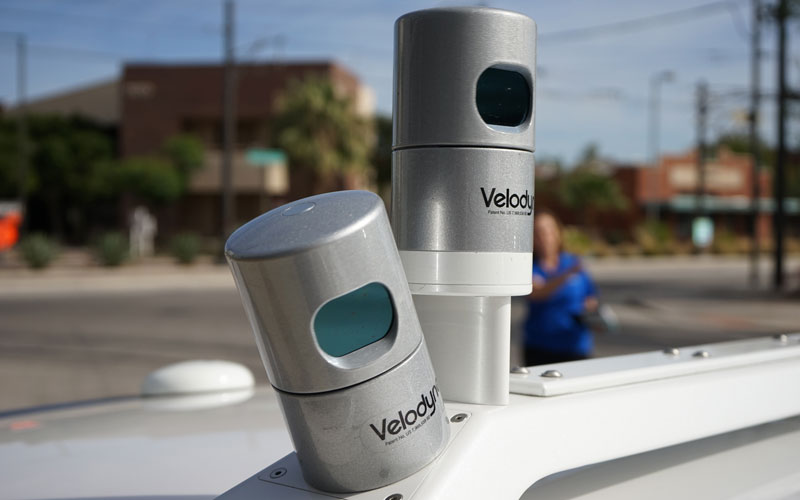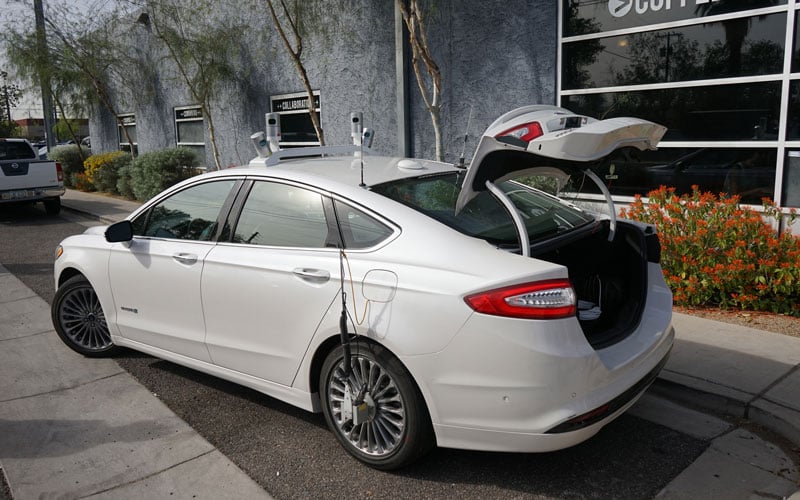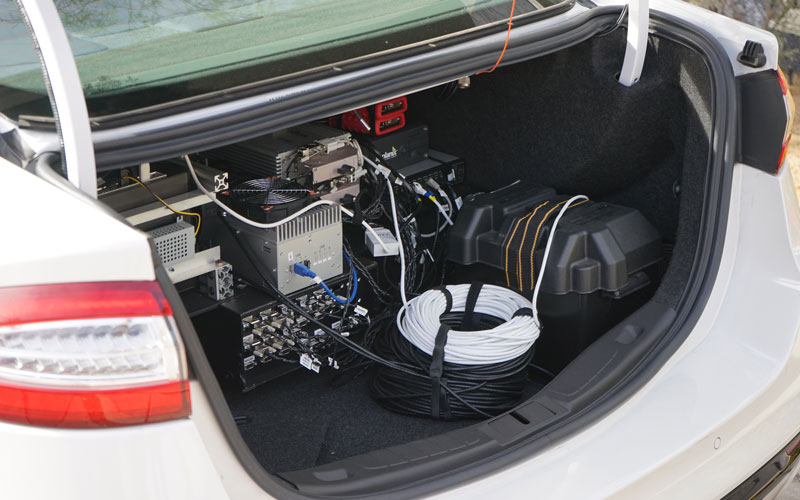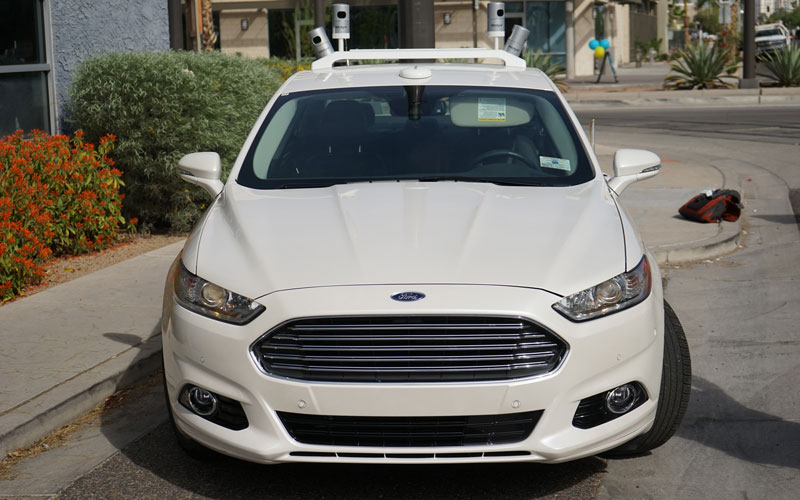
The lidar sensors atop the car were developed by Velodyne. Ford Motor Co. showcased a prototype version of an autonomous Fusion sedan at an event at Phoenix co-working space CO+HOOTS on Wednesday. (Photos by Travis Arbon/Cronkite News)

Ford Motor Co. showcased a prototype of an autonomous Fusion sedan at an event at Phoenix co-working space CO+HOOTS on Wednesday.
(Photos by Travis Arbon/Cronkite News)

The prototype’s self-driving functionality is processed by an array of computers and sensors that Ford officials say are roughly equivalent to the power of five laptops.
(Photos by Travis Arbon/Cronkite News)

The four lidar sensors that were developed by Velodyne sit atop the vehicle and use lasers to create a 3D image of the surroundings.
(Photos by Travis Arbon/Cronkite News)
Ford Motor Co. showcased its version of an autonomous vehicle at an event at Phoenix co-working space CO+HOOTS on Wednesday.
The company is testing a self-driving Fusion sedan at a facility in Wittmann, where the automaker also performs stress testing on its products.
Ford is not alone. Driverless cars are the latest trend in the auto world, with Google, Tesla and others making forays into the space. Auto and tech companies are racing to be the first to tap into what management consulting firm Boston Consulting Group estimates will become a $42 billion market by 2025.
Jim McBride, technical lead for autonomous vehicles for Ford, said the company wants to create a fully autonomous experience and go beyond systems that still require occasional input from the driver. Tesla’s version, for example, keeps cars within lanes while maintaining a constant speed, but it needs human intervention for stopping or signalling a lane change, according to azcentral.com.
“We’re not going to ask the driver to intervene,” McBride said. “We just don’t think it’s a fair proposition to drive for many miles and suddenly it stops running and says ‘Hey, now it’s your turn.'”
Ford’s prototype uses four cylindrical lidar sensors that sit atop the vehicle like a set of antennae. They produce a low humming noise as they spin. The devices spit lasers at about three million times per second in all directions and read the reflections to produce a 3-D map of the area around the vehicle.
The car compares that continuously generated view with preloaded maps of the area to discover the best routes and adjust on the fly to unpredictable traffic situations.
A computer array – equivalent to five consumer-grade laptops – in the trunk handles the processing. McBride said the next step is to condense the sensors into a less conspicuous and more cosmetically appealing hockey puck-shaped device.
Quirky rooftop ornaments aside, Ford’s prototype looks nearly identical to any other white Fusion sedan. And though the company wants to make the car look good, McBride said the more pressing challenge is making sure it’s safe.
“If you want a car which is fully autonomous in that it will let the driver disengage from the driving task, you have to have an enormous degree of robustness and reliability,” McBride said. “To that end, everything on our car will be fault tolerant and redundant.”
While Ford has only tested the car in Michigan and Arizona, McBride said the company has plans to expand operations to California and elsewhere for use on public roads. Ford did not show the car in action at Wednesday’s event. Arizona Department of Transportation officials said the agency is working on ways to fully accommodate self-driving cars.
As autonomous vehicles inch closer to consumer production, some have expressed concerns about safety on the road. Google’s self-driving car recently collided with a bus in Mountain View, California, in February, according to Reuters.
On Tuesday, automotive organization AAA released the results of a phone survey of more than 1,800 drivers nationally on attitudes toward self-driving cars. The study indicated 75 percent of drivers surveyed said they had fears about using an autonomous vehicle.
AAA Arizona spokeswoman Michelle Donati said attitudes often flip once people have a chance to use autonomous or semiautonomous systems.
“This isn’t necessarily uncommon with technology as a whole,” Donati said. “When self-parking technology became mainstream, a lot of people were very hesitant about it. We’ve done studies that show that the self-parking technology can park better than you can as a driver, so if you give up that control and give it to technology, that technology can outperform you the majority of the time.”
Other issues involve the data Ford plans to collect on the vehicle’s use once the product hits the mass market. McBride said ideally, Ford would use information from each car to improve routes and account for environmental changes. He said data collection would require an opt-in and compared it to existing systems on smartphone mapping apps.
McBride said Ford plans to incorporate driverless functionality into consumer vehicles within the next few years. And while the prototype is prohibitively expensive, he said savings could come from eliminating features like lane assist that become redundant when the car drives itself. McBride did not give a price estimate for the consumer version.
“Our goal, when we get to production, is to make it affordable to the masses,” McBride said. “Almost all of the cars today that have cruise control or lane assist have a radar on the car, and those radars used to cost $20,000 or more … and now we’ve come down to it costing you a couple hundred dollars for most car systems. I would see that same sort of progression to happen fairly rapidly.”